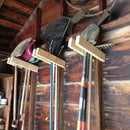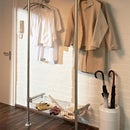Introduction: Corner Computer Desk Made With Pipe and Plywood
With some pipe, fitting, and a left over piece of plywood I made this great desk to adorn our living room corner.
Step 1: The Plan & Parts
The plan was to use some fence pipe, some Kee Klamp fittings, and a half a piece of plywood to make a corner desk for my living room. Our house has a minimalistic aesthetic so I wanted to create something clean and functional.
Here's the Parts List:
Wood
I used a half a piece of oak plywood that I had in my basement. So roughly 48" x 48"
Pipe
I'm giving you the cuts and you can figure out what lenghts of pipe work best for you. This is just plain ole cheap fence pipe from the home store.
5 x 27" legs
2 x 33" horizontal supports for back
3 x 17" horizontal supports for sides
Fittings
I'm a part owner of Simplified Building Concepts, so of course I got my fittings at a discount. Here are the quantities I used and links to where you can get them on the web site. If you are going to build this exact desk, let me know in the comment field on checkout and I'll throw in an additional 5% discount on the fittings
5 x L61-7 - Flange 1-1/4" - these hold the pipe to the plywood
2 x L10-7 Single Socket Tee 1-1/4" - these terminate the horizontal supports against the front legs.
3 x L21-7 - Side Outlet Tee 1-1/4" - these hold the horizontal supports to the back legs.
5 x 77-7 Plastic Plug - this goes into the end of the pipe and keeps the floor from getting scratched.
Other Stuff
After I was done my wife made a "skirt" for the desk with some fabric, some wire and some eyelets.
Here's the Parts List:
Wood
I used a half a piece of oak plywood that I had in my basement. So roughly 48" x 48"
Pipe
I'm giving you the cuts and you can figure out what lenghts of pipe work best for you. This is just plain ole cheap fence pipe from the home store.
5 x 27" legs
2 x 33" horizontal supports for back
3 x 17" horizontal supports for sides
Fittings
I'm a part owner of Simplified Building Concepts, so of course I got my fittings at a discount. Here are the quantities I used and links to where you can get them on the web site. If you are going to build this exact desk, let me know in the comment field on checkout and I'll throw in an additional 5% discount on the fittings
5 x L61-7 - Flange 1-1/4" - these hold the pipe to the plywood
2 x L10-7 Single Socket Tee 1-1/4" - these terminate the horizontal supports against the front legs.
3 x L21-7 - Side Outlet Tee 1-1/4" - these hold the horizontal supports to the back legs.
5 x 77-7 Plastic Plug - this goes into the end of the pipe and keeps the floor from getting scratched.
Other Stuff
- Edge Tape (Iron on kind) - for making the edge of the plywood look nice
- Screws - for attaching the flanges to the plywood
- Stain - for making the table look nice. (I used Minwax polyshades stain & polyurethan in one)
- Hex Key - for tightening down the fittings
- Screw driver
- Wood Block
- Box Cutter (or sharp straightedge of some sort)
- Iron - for attaching the edge tape
- Circular Saw - for cutting the plywood
- Sandpaper, Tac Cloth and Steel Wool for smoothing our the stained surface.
- Pipe Cutter
- Vise
After I was done my wife made a "skirt" for the desk with some fabric, some wire and some eyelets.
Step 2: Cuts & Staining
First order of business was to cut a section out of the corner of the board where the person would sit at the computer. This is where the keyboard would go.
I measured 24" up from each side, drew a line across and then ripped a cut across the corner of my 4' x 4' section of plywood.
That left me with a nice superman shaped piece of wood.
Staining
I sanded the top before staining and wiped it down with a tac cloth. Then I applied several coats of the stain/poly combo. In between each coat i waited for it to dry and either lightly sanded it or used steel wool to smooth it out. In short, follow the instructions on the stain you buy.
I measured 24" up from each side, drew a line across and then ripped a cut across the corner of my 4' x 4' section of plywood.
That left me with a nice superman shaped piece of wood.
Staining
I sanded the top before staining and wiped it down with a tac cloth. Then I applied several coats of the stain/poly combo. In between each coat i waited for it to dry and either lightly sanded it or used steel wool to smooth it out. In short, follow the instructions on the stain you buy.
Step 3: Edging the Top
This was going in our living room so I wanted it to have a nice clean edge. So I bought some iron on edge tape. This was surprisingly easy to use.
I precut my pieces LONGER than the edge itself. So I would line up one edge and the leave some hanging off the other side. I would press the iron on to the strip on the edge and run it along slowly (this is in the instructions on the edge stripping). I then ran a wood block over the strip to make sure that it was completely smooth. I then used the box cutter to very carefully and accurately cut of the extra. I then lightly sanded the edge so that it was a nice smooth transition from edge to edge.
This was my first time doing this and I was very pleased with the results.
After I did this, I applied one more coat of stain and poly, this time applying it to the wood edge strip that I just placed on.
I precut my pieces LONGER than the edge itself. So I would line up one edge and the leave some hanging off the other side. I would press the iron on to the strip on the edge and run it along slowly (this is in the instructions on the edge stripping). I then ran a wood block over the strip to make sure that it was completely smooth. I then used the box cutter to very carefully and accurately cut of the extra. I then lightly sanded the edge so that it was a nice smooth transition from edge to edge.
This was my first time doing this and I was very pleased with the results.
After I did this, I applied one more coat of stain and poly, this time applying it to the wood edge strip that I just placed on.
Step 4: Legs and Fittings
I cut all my pipe to length with a basic pipe cutter, nothing fancy. I highly recommend holding the pipe in a vice (though not too tight or you'll dent your pipe).
After the pipe was cut I assembled the legs and bracing (see picture)
After the flanges are screwed in I placed the bracing back into the flanges and tightened down the set screw.
In the bottoms of the pipe I inserted plastic pipe caps. These keep the pipe from scratching up the floor.. very important!
After the pipe was cut I assembled the legs and bracing (see picture)
- Fittings tighten down on the pipe with a set screw.
- You can set the brace at any height, I put mine lower to the ground.
After the flanges are screwed in I placed the bracing back into the flanges and tightened down the set screw.
In the bottoms of the pipe I inserted plastic pipe caps. These keep the pipe from scratching up the floor.. very important!
Step 5: Finsihed Desk
Make sure all your fittings are tight.. flip it over and you're done. It's a very simple desk and we really like the look of it.
My wife "enhanced" the desk by adding a "skirt" to it.
My wife "enhanced" the desk by adding a "skirt" to it.





